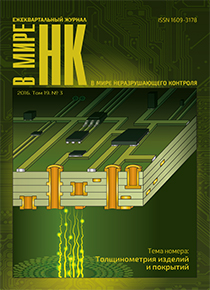Energy dispersive X-ray fluorescence analysis (ED XRF) enables the qualitative and quantitative elemental material composition to be determined, as well as thicknesses of multilayer coatings to be measured. Nowadays this method has been implemented in modern equipment, which is widely used both in laboratory measurements and in industry. The article describes the basic principles of the method and gives an overview of its different applications. Special attention is paid to the following industrial applications: thickness measurement of immersion gold on circuit boards; thickness measurement and composition of electroless Nickel; thickness measurements of electroplated tin; measurements of silicate coatings; measurements of turbine blade heat-resistant coatings. Experimental researches were carried out; measurements were made with the FISCHERSCOPE X-RAY analyzer manufactured by the company “HELMUT FISCHER GmbH” (Germany). The experimental results for different samples are presented as well as the ways of solving the arising problems. The ED XRF method has proven to be highly efficient for abovementioned industrial applications. The growth of scientific and technological progress is creating new possibilities for wider application of the ED XRF method including problems of non-destructive testing.
X-ray fluorescence analysis, elemental composition, multilayer coating, coating thickness
1. Rößiger V., Nensel B. Handbook of Practical X-Ray Fluorescence Analysis. Springer, 2006, 889 p.
2. Glaum M. Fortschritte in der Analyse kleiner Strukturen mit der µ-Röntgenfluoreszenz Vorteile des Array-Modes und Halo-freier Kapillar-Optiken beim Messen von Solder-Bumps und Copper Pillar. Application note, 2015 (in German).
3. Rößiger V., Zur Prozessanalytik von Dünnschicht-Solarzellen mit Röntgenfluoreszenz. Galvanotechnik, 2009, issue 6, pp. 1400-1407 (in German).
4. Dill S., Rößiger V. Coating thickness measurement of thin gold and palladium coatings on printed circuit boards using X-ray fluorescence. Circuit World. 2011, v. 37, no. 2, pp. 20-26.





